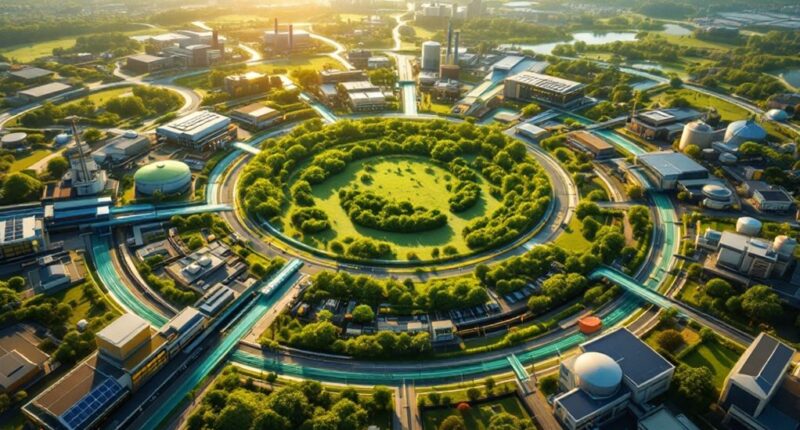The circular economy reimagines our “take-make-waste” model into a regenerative system where nothing truly becomes trash. Products are designed for durability, repair, and eventual recycling—think smartphones built for upgrades rather than replacement. This approach offers a $4.5 trillion economic opportunity by 2030 while potentially slashing CO2 emissions by 48%. From fashion’s recycled fibers to construction’s “material banks,” industries worldwide are embracing this nature-inspired framework where yesterday’s products become tomorrow’s resources.

The relentless march of traditional “take-make-waste” economics has finally met its match in the circular economy—a revolutionary framework that reimagines our relationship with resources. Unlike our current linear system, where products inevitably become waste, the circular economy keeps materials flowing in continuous, value-preserving loops. It’s like nature’s playbook applied to business—nothing is wasted, everything transforms.
At its core, the circular economy stands on three pillars: eliminating waste and pollution, keeping products and materials in use, and regenerating natural systems. Companies are designing products with their entire lifecycle in mind—creating items that can be easily repaired, reused, or recycled. It’s goodbye to the “death by obsolescence” approach and hello to modular designs that evolve with consumer needs.
The circular revolution replaces throwaway culture with intelligent design that gives products multiple lives and purpose beyond their first use.
Meanwhile, renewable energy powers these processes, creating a system that runs on sunshine rather than depleting underground reserves. This sustainable approach focuses on extending product life through innovative methods and technologies. Pioneering companies like Grover are demonstrating how rental business models can dramatically reduce waste while maintaining profitability in the electronics sector.
The business world is embracing this paradigm shift with innovative models. Subscription services are replacing ownership—why buy a refrigerator when you can lease cooling services? Companies are transforming into product stewards through take-back programs and refurbishment operations. Your old smartphone isn’t trash; it’s tomorrow’s raw materials.
This circular approach is reshaping industries globally. Fashion brands create clothing from recycled fibers and offer repair services. Electronics manufacturers design modular devices for easy upgrades. Even construction companies are embracing “design for disassembly,” treating buildings as material banks for future projects.
The economic rewards are substantial—a projected $4.5 trillion opportunity by 2030, with 700,000 new jobs in the EU alone. Beyond profit, the environmental benefits are staggering: potential 48% reduction in CO2 emissions and 32% less primary material consumption by 2030. These transformative strategies help businesses address the climate and biodiversity emergencies through more sustainable resource management.
Governments are catching up, implementing extended producer responsibility schemes and tax incentives for circular businesses. The circular economy isn’t just a trendy concept—it’s the blueprint for a resilient economic system that thrives within planetary boundaries.
After all, on a finite planet, shouldn’t our economic model reflect that reality?
Frequently Asked Questions
How Does the Circular Economy Impact Job Markets?
The circular economy profoundly reshapes job markets by creating millions of new positions while phasing out others.
It shifts employment from resource extraction toward repair, recycling, and remanufacturing sectors. By 2030, estimates suggest 7-8 million new jobs globally, with substantial growth in the EU and Latin America.
The change requires workforce upskilling in technical areas like repair and design. While creating economic opportunities worth $4.5 trillion by 2030, concerns exist about inclusivity, particularly in the Global South.
What Are Major Barriers to Implementing Circular Economy Practices?
Major barriers to implementing circular economy practices include technical limitations and knowledge gaps, particularly within smaller businesses.
Economic obstacles present significant challenges too, with high initial investments and competition from traditional linear models.
Regulatory inconsistencies across jurisdictions create compliance headaches for companies.
Perhaps most stubborn are cultural barriers – consumer preference for new products and corporate resistance to change continue to slow the shift toward circular systems.
Which Countries Lead in Circular Economy Adoption?
The Netherlands leads global circular economy adoption with an impressive 24.5% circularity rate and ambitious goals for 100% circularity by 2050.
France follows with innovative policies like banning destruction of unsold products and implementing mandatory repairability indexes.
The EU broadly supports these efforts through its Circular Economy Action Plan, while Finland, Germany, Italy, and Sweden have each developed distinctive national approaches.
Outside Europe, China, Japan, and Costa Rica have established extensive circular economy frameworks.
How Does Circular Economy Differ From Sustainability?
The circular economy and sustainability differ in scope and approach.
While sustainability broadly encompasses environmental, social, and economic well-being, circular economy specifically focuses on closing material loops and eliminating waste.
Sustainability aims for long-term ecological balance across multiple dimensions, while circularity targets resource management through intentional system redesign.
Though interconnected (circularity is fundamentally a subset of sustainability), they differ in measurement too—circular economy uses material flow indicators while sustainability employs the triple bottom line: people, planet, and profit.
What Metrics Measure Circular Economy Success?
Several metrics effectively gauge circular economy success.
Key Performance Indicators like Linear Flow Index and Material Circularity Indicator assess virgin material use and product circularity respectively.
Material Flow Analysis quantifies resource flows throughout value chains.
Life Cycle Assessment evaluates environmental impacts across product lifecycles.
The Circular Economy Indicators Coalition framework connects these metrics, creating an extensive measurement system.
These tools help organizations track their shift from linear to circular models and quantify real-world impacts of circularity initiatives.









